Demand continued to increase worldwide, with sales growing across the industry. Palfinger reported revenues of EUR504m for the first three quarters of 2007, up from EUR437m last year, and Tadano saw net crane sales for 2007 of JPY139bn, up from JPY116bn in 2006.
Increased sales and bottlenecks in component supply pushed backlogs and stretched waiting times for new cranes. Terex, for example, reported a $1.2bn backlog on March 31, rising to $1.41bn at the end of June, and $1.74bn in their third quarter results to September 30. US rivals Manitowoc reported even stronger backlog figures, starting at $1.9bn in the first quarter to 31 March, up to $2.1bn on 30 June, and $2.7bn on September 30.
While these figures suggest that the industry will remain strong over the medium term, Manitowoc CFO Carl Laurino reiterated a warning at the company’s third quarter conference call that “backlog is just one metric of the state of the crane cycle, and one that has inherent volatility.” Indeed, in past cycles, backlogs have collapsed rapidly as cancellations outstrip new orders: an effect that may be enhanced as reports of falling demand dent confidence and perceptions of resale value among buyers.
Speaking to Cranes Today in June, Manitowoc CEO Glen Tellock pointed to one strategy crane builders are following to avoid the impact of changes in demand: “Part of the acquisitions of Potain and Grove were to get a global footprint. Our strategy is how we minimise the impact of the swings in the North American market.”
Manitowoc is continuing to spread globally: this year, it formed a new business, Potain India, with former licensee Shirke, opened a new factory in Slovakia, and extended its production facility at Baltar in Portugal. Terex Chiangjiang brought its first new model, as a Terex brand, to this year’s Bauma, and Terex is said to be pursuing a deal with ABG Heavy Industries of India.
Palfinger and ETA of Dubai announced a distribution deal in India. Tadano complemented its existing Chinese crane building joint venture, BQ Tadano, with a new component manufacturing joint venture, JC Tadano. In October, Konecranes bought into South African crane manufacturer Dynamic Crane Systems, and announced it planned to take full control of the company within two years. Link-Belt revealed plans to re-enter Europe, announcing at Bauma that it was close to completing CE certification of its HTT 8690 telescopic truck crane.
The increasing globalisation of the crane industry wasn’t a one-way street from the developed world to emerging markets, however. In February, Action Construction (ACE) of India used its Cyprus division to buy SC Forma of Romania, with the aim of entering the European market. Chinese manufacturers were also looking west, with the country’s mobile and crawler builders making inroads into Europe at Bauma.
As well as building capacity and making deals overseas, manufacturers reacted to demand by upgrading their domestic plants. Sennebogen built a second plant in Straubing, Manitowoc extended its plants at Shady Grove and Port Washington, and Liebherr increased production at Ehingen. Link-Belt extended its Lexington facility, and Terex upgraded its Waverly plant. Kobelco announced expansion plans for two plants in Hyogo prefecture, Japan, and Tadano set about a complete overhaul of its Japanese crane manufacturing operations.
It wasn’t just manufacturers that were taking advantage of the boom time to build their business; rental fleets saw a wave of consolidation. Boom continued to expand in Australia, buying GM Baden in March, D&D Crane Hire in April and Moorland Hire in June. In Spain, Euroloc bought Catalan regional rental firm Grúas Homs, in June 2007, and co-operative group group Eurogruas extended its business into Morocco with a new business, Eurogrues Maroc.
Asian leader Tat Hong made acquisitions or launched new business in the UAE, China, Macau and Australia. Belgian tower specialist Arcomet bought out the crane fleet of its UK partner, Airtek, and became the distributor for Potain in Ireland.
Two of the world’s biggest fleet owners started the year by buying smaller rivals, and continued by transferring ownership from founders. In the US, AmQuip acquired Shaughnessy Crane Services in March, and was then sold by founder Joe Wesley to his executive board, backed by Bard Capital. In the UK, the Ainscough brothers first added Crane Services to Ainscough Crane Hire in March, and then sold the expanded company in October, in an MBO backed by the Bank of Scotland.
While crane usage remained strong, so, sadly, did accident figures. At the start of the year, in the UK, Falcon Crane Hire had its fleet temporarily grounded after a fatal accident in Liverpool, the second to hit it less than six months. Later, another tower crane, owned by Select, collapsed in Croydon, leading to questions over the safety of climbing cranes, and calls for a mandatory retirement age for all tower cranes.
In Washington State, USA, the findings of an investigation into a collapse in Seattle in 2006 lead legislators to push through new laws tightening inspection of crane bases, and new certification schemes for operators and inspectors. Across the US, legislators in Florida also looked to increase regulation. On a positive note, the NCCCO announced a new certification schemes for signallers and riggers. More recently however, an investigation in New York State found that more than a hundred operators had received certificates despite failing practical exams, with problems stretching back almost thirty years.
In Hong Kong, another fatal accident lead to a wave of inspections, and new training courses for crane crew.
In other words, it was an extraordinarily busy year for the crane industry around the world. As Neil Partridge, the new managing director of Ainscough Crane Hire said in an interview in Cranes Today in November, “These are great times to be operating a crane rental company in.”






